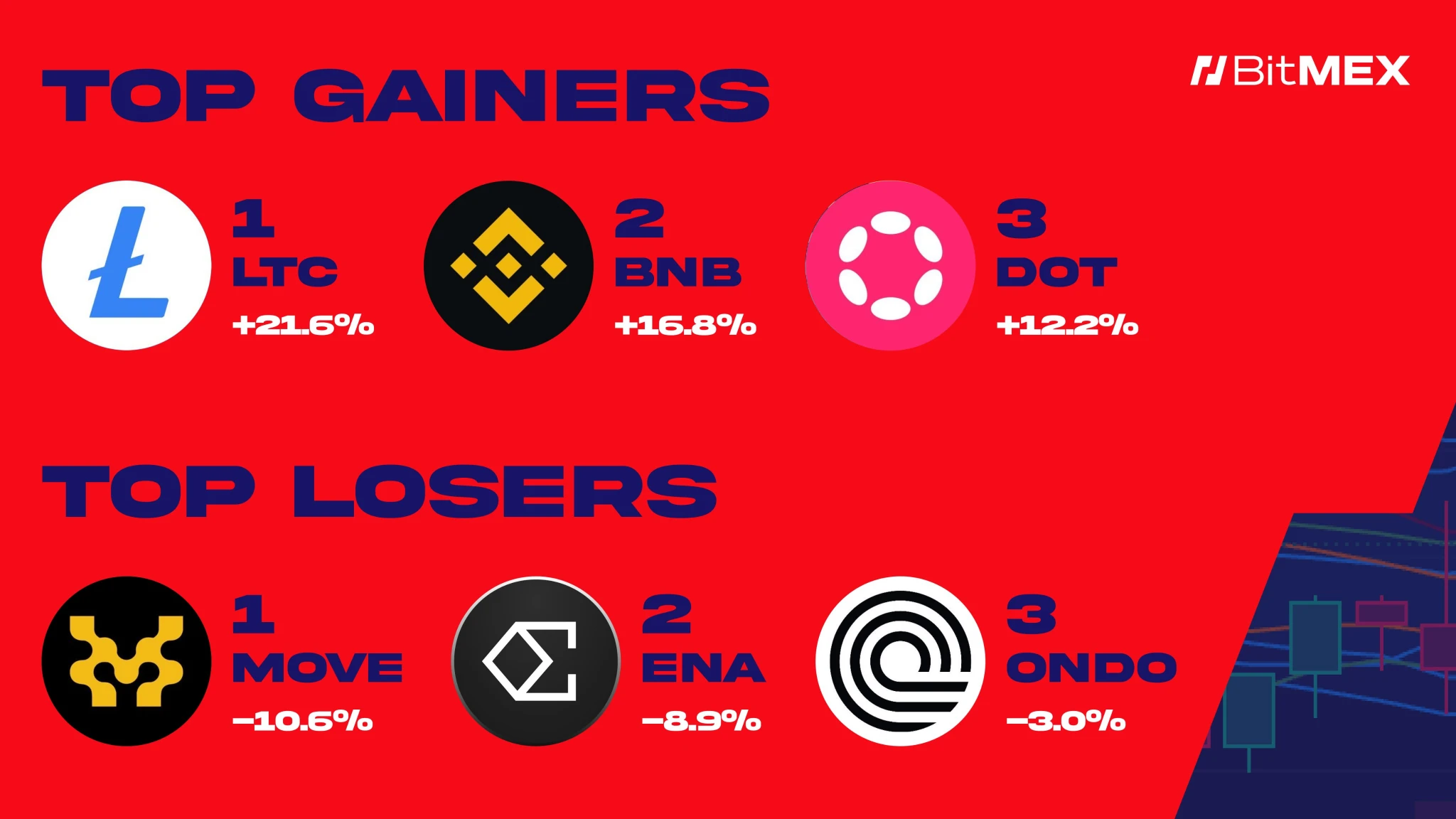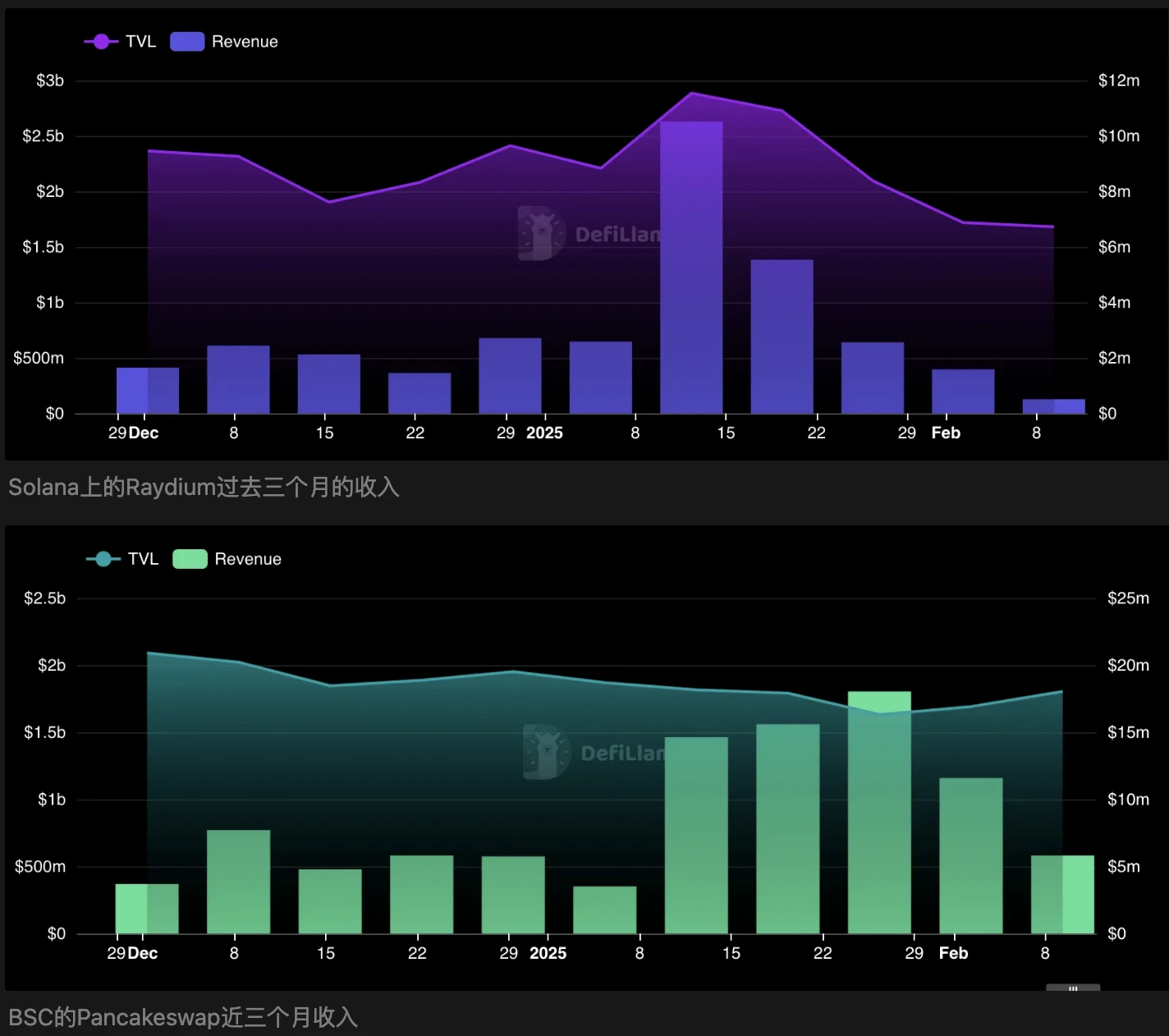Original Author: BitMEX Alpha
Key Points Overview
Despite poor inflation data and negative macro factors such as continuous ETF outflows, market prices have not declined, indicating that the market may have bottomed out.
Litecoin (LTC), BNB, and Polkadot (DOT) performed outstandingly, with increases of 21.6%, 16.28%, and 12.2%, respectively; while MOVE, ENA, and ONDO performed poorly, with declines ranging from -3% to -10.6%.
In the trading strategy section, we will analyze the valuation gap between decentralized exchanges (DEX) and centralized exchanges listed in the U.S. — will undervalued tokens become one of the best trading opportunities in this bull market?
Data Overview

Best Performers This Week
$LTC (+21.6%): Litecoin surged strongly under ETF expectations, about to break through a key price level.
$BNB (+16.28%): As the fourth-largest cryptocurrency by market cap, Binance Coin rarely surged 15%. CZ expressed support for meme coins on BSC, driving a surge in BNB demand.
$DOT (+12.2%): As Ethereum faces pressure, traders are turning their attention to the Polkadot ecosystem developed by ETH's former CTO.
Worst Performers This Week
$MOVE (-10.6%): MOVE is overvalued compared to emerging public chains like Berachain, leading to price pressure and decline.
$ENA (-8.9%): ENA continues its downward trend with no signs of stabilization.
$ONDO (-3%): ONDO has entered a mild adjustment phase, with a slight decline of 3% this week.
Market News
Macroeconomic Dynamics
Ethereum ETF saw outflows of $50 million this week.
Bitcoin ETF experienced a net outflow of $677 million this week.
U.S. January inflation recorded the fastest growth in 18 months.
Barclays Bank holds $131 million in Bitcoin through BlackRock ETF.
Coinbase reported $2.3 billion in revenue for the fourth quarter, making progress in regulatory compliance.
Robinhood's fourth-quarter crypto trading revenue increased eightfold, creating competitive pressure on Coinbase.
Trump's World Liberty Fi increased its holdings in MOVE and staked Ethereum.
SEC is reviewing more Solana ETF applications, increasing the likelihood of approval.
North Carolina becomes the 20th U.S. state to propose Bitcoin reserve legislation.
Federal Reserve Chairman Powell maintains interest rates, supports stablecoin regulation, and opposes the de-financialization of the banking industry.
Project Developments
Jupiter DEX will launch a JUP token buyback next Monday.
Former Binance CEO Zhao Changpeng hinted at launching a meme coin.
Grayscale submitted a spot Cardano ETF application to the SEC.
SEC confirmed receipt of Grayscale's XRP ETF proposal, entering the federal review stage.
MyShell snapshot completed, and $SHELL token is about to be released.
ZkLend suffered a $9.5 million hack, offering a 10% bounty for the return of funds.
OpenSea confirmed an upcoming token airdrop and expansion into cryptocurrency trading.
Trading Strategy
Disclaimer: The following content does not constitute investment advice. This is merely a summary of market news, and it is recommended that you conduct your own research before making any trades. The content does not represent any guarantee of returns, and BitMEX is not responsible for your trading performance.
Tokens with Real Revenue May Become the Most Undervalued Investment Opportunities in the Market
The rise of decentralized exchanges (DEX) is one of the most transformative developments in the cryptocurrency space. Despite these DEX generating billions of dollars in real revenue annually and implementing active token buyback programs, the valuations of DEX tokens remain significantly lower compared to traditional exchanges like Coinbase (COIN) or Robinhood (HOOD). Even in a volatile market environment, the stocks of cryptocurrency exchanges and brokerage platforms (like Robinhood) continue to perform strongly, with their latest financial reports highlighting the ongoing growth trend in cryptocurrency trading.
Take Robinhood as an example; its trading revenue increased by 200% year-over-year, primarily due to the booming cryptocurrency business. The company's total revenue grew by 115% year-over-year, reaching $1.01 billion. Notably, trading revenue surged 200% year-over-year to $672 million, with cryptocurrency revenue accounting for a significant share at $358 million, a 700% year-over-year increase. Additionally, options trading revenue grew by 83%, and stock trading revenue increased by 144%.
In light of such impressive performance and explosive growth in cryptocurrency trading, one must ask: If Robinhood's stock price rises due to its growth in cryptocurrency revenue, how should we assess the value of existing crypto projects that also generate hundreds of millions in revenue? These projects, especially DEX, are not only thriving in the industry but also implementing mechanisms like token buybacks that Robinhood does not have. Would investing in DEX tokens with real revenue and capital return commitments be a wiser choice compared to simply investing in traditional exchanges?
Price-to-Earnings Ratio Analysis: DEX Valuations Are Just a Fraction of Traditional Exchanges
Traditional exchanges are overvalued relative to their revenue. For instance, Coinbase (COIN) has a market cap of $74 billion, which is 11.2 times its annualized revenue of $6.6 billion. Similarly, Robinhood (HOOD) has a market cap of $56 billion, which is 18.6 times its annual revenue of $3 billion.
In contrast, leading decentralized exchanges (DEX) have significantly lower valuation multiples despite faster growth and unique advantages:
Raydium: Price-to-earnings ratio of 5-6 times
Market cap of $1.5 billion, annual revenue of $250 million to $300 million
Jupiter: Price-to-earnings ratio of 6 times
Market cap of $2 billion, annual revenue of $300 million to $400 million
Metaplex: Price-to-earnings ratio of 5 times
Market cap of $230 million, annual revenue of $40 million to $50 million
Hyperliquid: Price-to-earnings ratio of about 12 times
Market cap of $8 billion to $9 billion, annual revenue of $500 million to $700 million
Although Hyperliquid's price-to-earnings ratio (12.7 times) is slightly higher than Coinbase's (11.2 times), its aggressive buyback policy (over 50% of transaction fees used for buybacks) and its dominance in the perpetual futures space make it an extremely attractive investment opportunity. The key difference is that Hyperliquid is not only growing rapidly but also conducting large-scale buybacks, while traditional exchanges like Coinbase have not implemented buyback programs, further highlighting the market's inefficiency in pricing DEX tokens.
Buybacks: A Catalyst for Enhancing Token Holder Value
An important feature of these projects is their commitment to rewarding holders through active buyback programs. Unlike Robinhood and Coinbase, these crypto projects implement token burn mechanisms, increasing scarcity and potentially driving up token value.
Compared to traditional exchanges, DEX is pioneering a deflationary token economic model through active token buybacks and burns:
Raydium: Allocates 12% of transaction fees for buybacks
Hyperliquid: Will allocate over 50% of transaction fees (approximately $684 million) for buybacks annually, reducing supply faster than any competitor, with an expected annual supply reduction of about 10%.
Jupiter: As the largest DEX on Solana, commits to using 50% of transaction fees (approximately $150 million to $200 million annually) for buybacks.
Metaplex: Burns $200,000 to $300,000 monthly (approximately $2.4 million to $3.6 million annually), accounting for 50% of $4 million to $5 million in transaction fees.
Risks: Cyclicality and Sustainability in the Crypto Market

While DEX tokens appear undervalued based on current price-to-earnings ratios and strong growth potential, we must also carefully consider the risks of investing in such projects. The primary risk is cyclicality — the crypto market is inherently cyclical, often experiencing explosive growth followed by prolonged adjustment periods. This cyclicality can significantly impact the revenue and trading volume of decentralized exchanges, making their profit forecasts more uncertain than in traditional markets.
Another key challenge facing DEX is the sustainability of growth. For example, while Raydium and Jupiter are currently performing well, they remain vulnerable to external factors. A recent surge in trading volume on the BNB chain is a typical case, stemming from Zhao Changpeng's promotion of meme coins on Binance's native chain. This led to a significant decline in trading volume on the Solana chain, subsequently affecting the revenue of Solana-based DEXs like Raydium and Jupiter.
This situation highlights the fierce competition between Layer 1 (L1) blockchains. As new trends emerge, certain ecosystems may quickly attract attention and liquidity, while the user base of other ecosystems may shrink. For instance, when the BNB chain gained attention due to the meme coin craze, Solana's market share was temporarily weakened, directly impacting the revenue of Solana ecosystem projects like Raydium and Jupiter. This ongoing volatility in trading volume can lead to instability in the prices and revenues of DEX tokens.
Moreover, the rise and fall of specific ecosystems or tokens, especially changes driven by speculative trends or shifts in user preferences, further increase the unpredictability of DEX token performance. While the long-term outlook for DEX remains positive, it is essential to fully consider the risks of cyclicality in the crypto market and the potential for sudden shifts in the competitive landscape when evaluating the sustainability of their revenue growth.
Conclusion: Investment Opportunities in DEX Tokens
Overall, despite the risks posed by market cyclicality and fierce competition between blockchain ecosystems, DEX tokens still offer investors highly attractive opportunities. The current market undervaluation of these tokens (reflected in lower price-to-earnings ratios and strong revenue growth) is noteworthy. More importantly, their active buyback programs (which traditional exchanges like Robinhood do not possess) provide an additional value creation mechanism that helps mitigate the impact of market volatility. As the growth rate of DeFi outpaces that of traditional exchanges, and as DEX continues to innovate and expand, investors willing to look beyond short-term fluctuations will encounter significant opportunities. As the market matures, the gap between the fundamentals of DEX and their token valuations is likely to narrow gradually, leading to substantial long-term gains. Now is the time to recognize the true value of these tokens — they are undervalued gems in a rapidly evolving market.
免责声明:本文章仅代表作者个人观点,不代表本平台的立场和观点。本文章仅供信息分享,不构成对任何人的任何投资建议。用户与作者之间的任何争议,与本平台无关。如网页中刊载的文章或图片涉及侵权,请提供相关的权利证明和身份证明发送邮件到support@aicoin.com,本平台相关工作人员将会进行核查。




